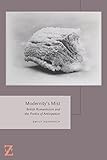Modernity's Mist : British Romanticism and the Poetics of Anticipation / Emily Rohrbach.
Material type: TextSeries: Lit ZPublisher: New York, NY : Fordham University Press, [2015]Copyright date: ©2015Description: 1 online resource (200 p.)Content type:
TextSeries: Lit ZPublisher: New York, NY : Fordham University Press, [2015]Copyright date: ©2015Description: 1 online resource (200 p.)Content type: - 9780823267965
- 9780823267996
- English literature -- 18th century -- History and criticism
- English literature -- 19th century -- History and criticism
- Literature and history -- Great Britain -- History -- 18th century
- Literature and history -- Great Britain -- History -- 19th century
- Poetics -- History -- 18th century
- Poetics -- History -- 19th century
- Romanticism -- Great Britain
- Time in literature
- Literary Studies
- LITERARY CRITICISM / Poetry
- Austen
- Byron
- Don Juan
- Future
- Keats
- Persuasion
- Temporality
- historiography
- poetics
- romanticism
- 820.9/145 23
- online - DeGruyter
- Issued also in print.
| Item type | Current library | Call number | URL | Status | Notes | Barcode | |
|---|---|---|---|---|---|---|---|
 eBook
eBook
|
Biblioteca "Angelicum" Pont. Univ. S.Tommaso d'Aquino Nuvola online | online - DeGruyter (Browse shelf(Opens below)) | Online access | Not for loan (Accesso limitato) | Accesso per gli utenti autorizzati / Access for authorized users | (dgr)9780823267996 |
Frontmatter -- Contents -- Acknowledgments -- INTRODUCTION: ON BEING IN A MIST -- 1. FROM PRECEDENTS TO THE UNPREDICTABLE: HISTORIOGRAPHICAL FUTURITIES -- 2. DIZZY ANTICIPATIONS: SONNETS BY KEATS (AND SHELLEY) -- 3. ACCOMMODATING SURPRISE: KEATS'S ODES -- 4. CONTINGENCIES OF THE FUTURE ANTERIOR: AUSTEN'S PERSUASION -- 5. THE "DOUBLE NATURE" OF PRESENTNESS: BYRON'S DON JUAN -- Notes -- Index
restricted access online access with authorization star
http://purl.org/coar/access_right/c_16ec
Modernity's Mist explores an understudied aspect of Romanticism: its future-oriented poetics. Whereas Romanticism is well known for its relation to the past, Emily Rohrbach situates Romantic epistemological uncertainties in relation to historiographical debates that opened up a radically unpredictable and fast- approaching future. As the rise of periodization made the project of defining the "spirit of the age" increasingly urgent, the changing sense of futurity rendered the historical dimensions of the present deeply elusive. While historicist critics often are interested in what Romantic writers and their readers would have known, Rohrbach draws attention to moments when these writers felt they could not know the historical dimensions of their own age. Illuminating the poetic strategies Keats, Austen, Byron, and Hazlitt used to convey that sense of mystery, Rohrbach describes a poetic grammar of future anteriority-of uncertainty concerning what will have been. Romantic writers, she shows, do not simply reflect the history of their time; their works make imaginable a new way of thinking the historical present when faced with the temporalities of modernity.
Issued also in print.
Mode of access: Internet via World Wide Web.
In English.
Description based on online resource; title from PDF title page (publisher's Web site, viewed 02. Mrz 2022)


